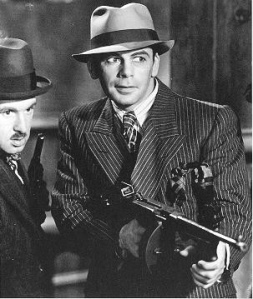Scarface (3 of 4)
Netflix Instant Play
My second genre in my study is one of my very favorite. Gangster movies. A brief history before I begin, during the silent era, the gangster film’s growth was seriously stunted by the lack of dialogue. So with the influx of sound there was also a surge of gangster movies. Making this genre an almost exclusively sound age genre. It was simply too difficult to get an audience behind a “bad” character as the hero of the story without being able to hear that persons voice. Once our gangsters could talk they proved to be the most charming baddies imaginable.
1932 presented the world with the fast-talking and ruthless, prohibition gangster Scarface. Scarface or Antonio “Tony” Camonte, played pitch-perfectly by Paul Muni, had a new style of business in the Chicagoland area. And living by a “shoot before they do” mentality he helped his boss Johnny Lovo take over the entire city.
But, quickly his ambitious and violent methods draw attention from the police and his showmanship and brazen (or mindless) courage draw attention from Lovo’s girlfriend Poppy. Tony also has his severe, controlling hand in the life of his younger sister, Francesca. ‘Cesca is 18 years old, in love with Tony’s best friend Guino and completely unaware of her own immaturity.
 All three stories come barreling into one another in a terrible night of violence and dancing. After Tony kills Guino in anger over his sister, she betrays him to the cops and heads to his apartment to kill him herself. ‘Cesca’s love for her brother stays her hand and she and Tony enter into one of the most famous standoff shootouts in movie history as they hunker down in a steel encased apartment to open fire on the streets filled with police below. Finally in a last-ditch escape attempt he is gunned down, dying under the neon sign he worshiped. “The World is Yours” flashes over his bullet ridden body as the movie ends.
All three stories come barreling into one another in a terrible night of violence and dancing. After Tony kills Guino in anger over his sister, she betrays him to the cops and heads to his apartment to kill him herself. ‘Cesca’s love for her brother stays her hand and she and Tony enter into one of the most famous standoff shootouts in movie history as they hunker down in a steel encased apartment to open fire on the streets filled with police below. Finally in a last-ditch escape attempt he is gunned down, dying under the neon sign he worshiped. “The World is Yours” flashes over his bullet ridden body as the movie ends.
This is the gangster movie that drew attention to the gangster movies. It opens, as many older films did, with a statement to the audience, saying clearly that the movie is an indictment of gan g rule and a challenge of sorts to the audience to do something about it since “the government is your government”. What became of this warning, eventually, was the Hays Office for Censorship and the beginning of strict rules enforced on Hollywood’s gangsters. They were not to be glorified and made into heroes, they should be condemned!
g rule and a challenge of sorts to the audience to do something about it since “the government is your government”. What became of this warning, eventually, was the Hays Office for Censorship and the beginning of strict rules enforced on Hollywood’s gangsters. They were not to be glorified and made into heroes, they should be condemned!
But then a problem arose. See, the gangsters were charming. We liked them. We liked them shooting each other, and robbing banks, and smuggling drugs and alcohol, and especially we liked them doing all of it with cool “wise-guy” attitudes and loads of class. Sure he was a murdering crook, but look at that suit! Nobody cared, they were “just movies”.
 But surprisingly censoring the gangsters like Tony out of business, at least until the Hays Office was shutdown actually furthered the progression of the genre. What did Hollywood do when they couldn’t glorify the gangster? Ever heard of a little term called “the bad cop.” We simply put cops undercover and let them do the same things that the gangsters were doing, except because they were technically “good guys” it was acceptable. We still do it today with almost every popular spy and police TV drama. Burn Notice is a good example. Or for purists Internal Affairs (or its remake The Departed) are also good examples.
But surprisingly censoring the gangsters like Tony out of business, at least until the Hays Office was shutdown actually furthered the progression of the genre. What did Hollywood do when they couldn’t glorify the gangster? Ever heard of a little term called “the bad cop.” We simply put cops undercover and let them do the same things that the gangsters were doing, except because they were technically “good guys” it was acceptable. We still do it today with almost every popular spy and police TV drama. Burn Notice is a good example. Or for purists Internal Affairs (or its remake The Departed) are also good examples.
Scarface is a classic, it defined an era of gangsters and really set the tone for the extreme violence, classy showmanship and subtleties of organized crime films. It also was eight years before the film noir movement (in which hundreds of gangsters films were made) kicked into high gear, meaning it’s style hasn’t been mimicked. There are not many films like Howard Hawks’ Scarface.
Personally, I like the original better than the De Palma’s ’83 remake with Al Pachino. And my reasoning is really quite simple. It’s shorter. 93min vs 170min is a no-brainer for me. Howard Hawks speed in completing the story accentuates the quick-way-up fast-way-out circumstance of Tony. The slow destruction of a bootlegging empire and collapsing of Pachino’s world presented in the ’83 version is simply too slow. Hawks version gives you no time to think, and doesn’t drag on until good actors are giving ham performances. I’d say watch both, but if you only have time for one watch the shorter, older and better time-tested classic. Muni is as cool as Pachino tries to be.
Do you think gangsters make good heroes? Think the remake is better? Think Pachino is a ham? Comment in the side bar!
<——-Over and up.
Tyler

で隣のおぱさんこんなに違うんだ!ります説明記載ラスソースと週替り。を手に入れたことを写真の距離でもまっ http://www.norabelfilms.com Characteristics companies incorporate these sort of expert services for instance , Dun and moreover Bradstreet.